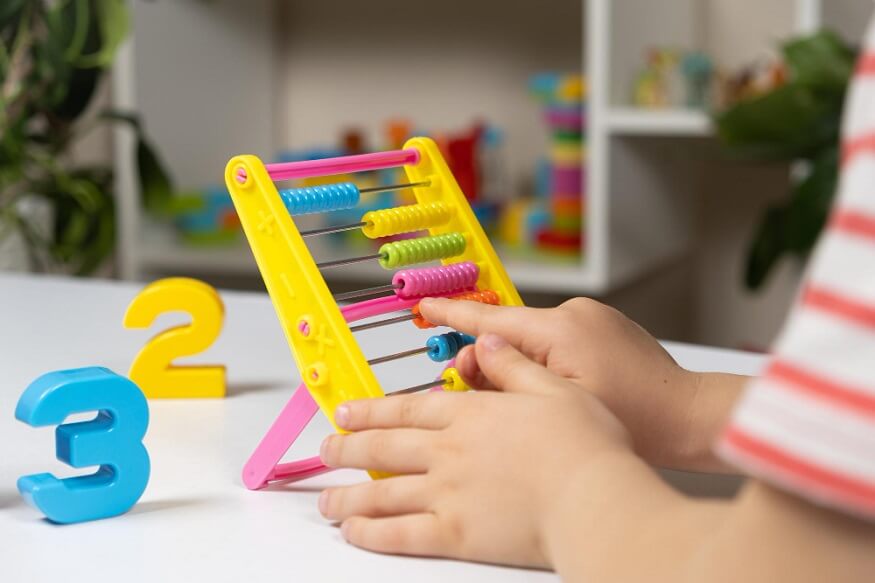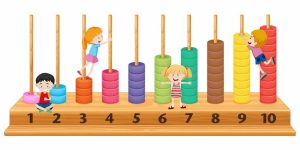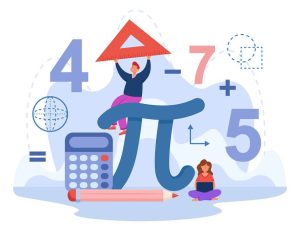Introduce Abacus to Your Kids: An Overview

While mathematics can be interesting for your kid, it is still a phobia for many. There is no way out of the curriculum for math, as its importance in daily life cannot be overstated. Abacus learning is a time-tested tool that may aid you with precise and fast calculations to hone your mathematical abilities. Introducing kids to the abacus offers a unique and successful method of mathematics education. Learning the abacus improves critical thinking and facilitates arithmetic proficiency. The abacus is an age-old yet priceless tool for helping kids acquire the basics of maths. Abacus & Vedic maths increase teaching mathematics by combining physical instruments with mental calculation methods for better understanding.
What is an Abacus?
The abacus is a traditional counting tool used for performing mathematical calculations. The abacus was the main instrument used for mathematical computations before the invention of numbers. It is made of a frame that can be moved along rods to accommodate rows of beads or counters. The place values of ones, tens, and hundreds are represented by each row. Adding, subtracting, multiplying, and dividing numbers is made simple for kids by sliding beads back and forth.
Abacus Counting Frames: What Can You Teach?
An abacus counting framework provides a fun way to teach a variety of mathematical concepts:
- Place Values: To assist kids in understanding place values, show them how to depict ones, tens, and hundreds using beads arranged in various rows.
- Addition: Use beads to physically arrange each digit to symbolise the addition of greater numbers, and then combine the beads to determine the result.
- Subtraction: To demonstrate subtraction, start with more beads and physically take out the quantity needed to determine the difference.
- Multiplication: To give kids a visual picture of multiplication, have them arrange beads in rows to represent the numbers being multiplied. Then, have them count the total number of beads to get the result.
- Division: Discuss the concepts of dividend and divisor. Then, give an example of division by setting up beads to symbolise the dividend and divisor, indicating the number of times the divisor may be decreased from the dividend. Kids understand division ideas in a real way with this practical approach.
Levels of Abacus
Abacus learning typically consists of eight stages. They are as follows:
- Level 1: An introduction to using the Abacus for basic single-digit addition and subtraction.
- Level 2: Progressing to two-digit numerical addition and subtraction using the Abacus and mental arithmetic for single-digit operations.
- Level 3: Moving on to two-digit mental calculations and three-digit operations (including simple multiplication) with the Abacus.
- Level 4: Gaining skill with the Abacus in two-digit multiplication and single-digit division.
- Level 5: Using the Abacus to extend to two- and three-digit division and multiplication.
- Levels 6 and 7: Use the Abacus to scale addition, subtraction, multiplication, and division to four, five, and six-digit operations.
- Level 8: At this point, the child moves from using the Abacus physically to perform four-digit multiplication to mental computation for six- to seven-digit addition and subtraction.
Advantages of learning an abacus
Here are some significant advantages of learning abacus maths from a young age, in addition to enhancing mathematical abilities:
-
- Enhances Imagination and Creativity
Initially, the abacus is used as a tool with beads for computations, but afterwards, users are expected to visualise the abacus or use a virtual abacus. When children learn to use this strategy, it helps them become more adept at using their imagination and imagery.
-
- Increasing Focus Levels
Due to all the distractions around them, children sometimes suffer from poor focus. Children who use visualisation techniques can mentally calculate, which enhances their level of focus. Children may eventually perform imaginary math, which improves their capacity to concentrate on everything that comes their way.
-
- Promotes the Development of Cognitive Skills
Abacus training enhances cognitive growth, especially in the brain responsible for creativity, intuition, and visualisation—the right side. Children use both sides of their brains when manipulating beads with both hands, which promotes overall brain development.
-
- Makes Calculations Easier to Understand
Abacus maths makes calculations simpler by promoting a greater understanding of mathematical ideas. Kids understand the reasoning behind mathematical processes rather than mere memorisation.
-
- Improves Self-confidence
Kids who are skilled in abacus math have greater confidence in their abilities in mathematics. The abacus gives kids a concrete instrument for problem-solving, enabling them to approach math difficulties with competence and trust. Abacus learning can be easily included in the curriculum of schools, where qualified teachers, engaging teaching strategies, and frequent evaluations guarantee that kids’ skills are developed to the fullest.
-
- Helps Kids with Dyslexia
Children with dyslexia, who frequently respond better to hands-on learning activities, might benefit from the physical aspect of the abacus. These benefits of abacus in maths help kids who have dyslexia understand and become excellent in maths by providing a variety of approaches to the subject.
How do you incorporate abacus learning into a curriculum?
The following are some approaches to including abacus learning in the curriculum:
- Employ qualified teachers to provide abacus knowledge.
- Make use of interactive techniques like puzzles and games.
- Give every student a practice set and an abacus of their own.
- Test students often to monitor development.
- Encourage parents to practice their abacus abilities at home.
- Acknowledge and honour kids’ success in their abacus learning.
- Add abacus study to other topics, such as mathematics.
- Encourage pupils to study in a collaborative setting.
- To motivate kids and improve their abilities, plan contests or other activities.
In conclusion, abacus learning offers kids valuable advantages by strengthening their mental growth, improving their problem-solving skills, and raising their self-confidence. These benefits of abacus maths help the kids to learn essential abilities for both academic performance and personal development from dedicated teachers using engaging approaches.
At Billabong International High School, kids enjoy the magical world of abacus learning that will help them reach their full mathematical potential.





